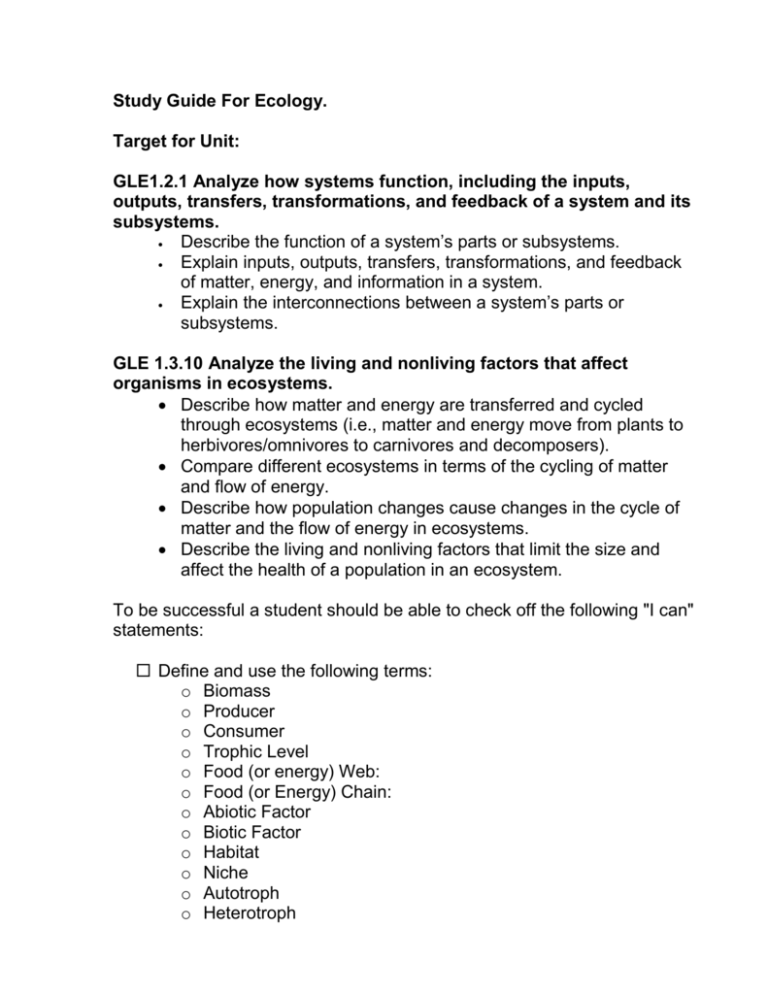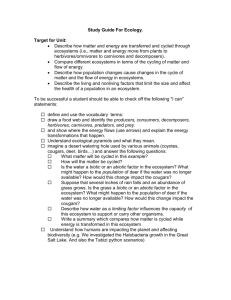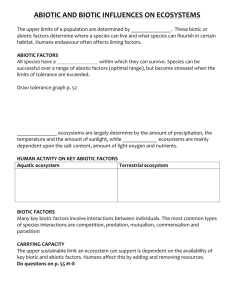Describe the function of a system`s parts or subsystems.
advertisement

Study Guide For Ecology. Target for Unit: GLE1.2.1 Analyze how systems function, including the inputs, outputs, transfers, transformations, and feedback of a system and its subsystems. Describe the function of a system’s parts or subsystems. Explain inputs, outputs, transfers, transformations, and feedback of matter, energy, and information in a system. Explain the interconnections between a system’s parts or subsystems. GLE 1.3.10 Analyze the living and nonliving factors that affect organisms in ecosystems. Describe how matter and energy are transferred and cycled through ecosystems (i.e., matter and energy move from plants to herbivores/omnivores to carnivores and decomposers). Compare different ecosystems in terms of the cycling of matter and flow of energy. Describe how population changes cause changes in the cycle of matter and the flow of energy in ecosystems. Describe the living and nonliving factors that limit the size and affect the health of a population in an ecosystem. To be successful a student should be able to check off the following "I can" statements: Define and use the following terms: o Biomass o Producer o Consumer o Trophic Level o Food (or energy) Web: o Food (or Energy) Chain: o Abiotic Factor o Biotic Factor o Habitat o Niche o Autotroph o Heterotroph o o o o o o Limiting Factor Herbivore Carnivore Omnivore Scavenger Decomposer draw a food web and identify the producers, consumers, decomposers, herbivores, carnivores, predators, and prey. and show where the energy flows (use arrows) and explain the energy transformations that happen. Understand ecological pyramids and what they mean. imagine a desert watering hole used by various animals (coyotes, cougars, deer, birds…) and answer the following questions: What matter will be cycled in this example? How will the matter be cycled? Is the water a biotic or an abiotic factor in the ecosystem? What might happen to the population of deer if the water was no longer available? How would this change impact the cougars? Suppose that several inches of rain falls and an abundance of grass grows. Is the grass a biotic or an abiotic factor in the ecosystem? What might happen to the population of deer if the water was no longer available? How would this change impact the cougars? Describe how water as a limiting factor influences the capacity of this ecosystem to support or carry other organisms. Write a summary which compares this ecosystem with the one shown on page --- in terms of how matter is cycled while energy is transformed. Understand how humans are impacting the planet and affecting biodiversity (e.g. We investigated the Halobacteria growth in the Great Salt Lake.)









